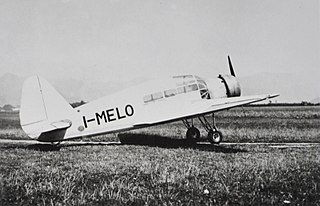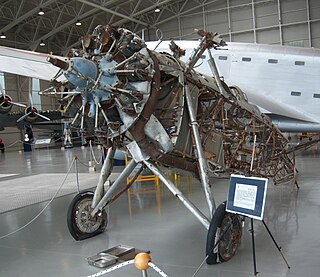Compagnia Nazionale Aeronautica was a manufacturer of aircraft and aircraft engines established in Italy in 1920 by Count Giovanni Bonmartini. Together with a group of World War I veteran pilots, he operated a flying school in Rome from a field that would eventually be developed into Littorio airport. For the next decade or so, CNA also developed their own aircraft and engines to power them. Bonmartini had also worked on an advanced racing motorcycle engine, the GBR in another partnership, and eventually CNA acquired the rights to this as well.
In 1934 Bonmartini sold CNA to Caproni. In turn, Caproni sold rights to the GBR engine to Gilera, who developed it as the Gilera 500 Rondine.
Types from Italian Civil and Military aircraft 1930-1945

Caproni, also known as Società de Agostini e Caproni and Società Caproni e Comitti, was an Italian aircraft manufacturer. Its main base of operations was at Taliedo, near Linate Airport, on the outskirts of Milan.

The Piaggio P.XI was an Italian 14-cylinder radial aircraft engine. The P.XI was a licensed derivative of the French Gnome-Rhône Mistral Major 14K produced in Italy. Isotta Fraschini also produced a version of the 14K called the K.14.

The Caproni Ca.314 was an Italian twin-engine attack/torpedo bomber aircraft, used in World War II.

The Caproni PS.1, also known as the Pallavicino PS-1 and Caproni Ca.303, was an Italian four-seater sportsplane, designed and built specifically to compete in Challenge 1934, the European touring plane championships.

The Caproni Ca.309 Ghibli was an Italian aircraft used in World War II. Its nickname 'Ghibli' refers to a desert wind and later served as the inspiration for animation Studio Ghibli's name.

The Caproni Vizzola F.5 was an Italian fighter aircraft built by Caproni. It was a single-seat, low-wing cantilever monoplane with retractable landing gear.

The IMAM Ro.63 was an Italian STOL aircraft designed for short-range reconnaissance and light transport during World War II.

The Caproni Ca.161 was an aircraft built in Italy in 1936, in an attempt to set a new world altitude record. It was a conventional biplane with two-bay, staggered wings of equal span, based on Caproni's Ca.113 design. The pressure-suited pilot was accommodated in an open cockpit.

The Stipa-Caproni, also known as the Caproni Stipa, was an experimental Italian aircraft designed in 1932 by Luigi Stipa (1900–1992) and built by Caproni. It featured a hollow, barrel-shaped fuselage with the engine and propeller completely enclosed by the fuselage—in essence, the whole fuselage was a single ducted fan. Although the Regia Aeronautica was not interested in pursuing development of the Stipa-Caproni, its design influenced the development of jet propulsion.

Capriolo, later called Aeromere, was the name of the motorcycle production arm of the Italian aircraft company Aeromere or Aero-Caproni. After World War II, the victorious Allies prohibited wartime aircraft and other military hardware suppliers from remaining in their previous industries, and Aero-Caproni would change its name to Capriolo and become one of several, including Aermacchi, MV Agusta, Vespa and Ducati, that switched to producing motorcycles or scooters. These companies did well until the mid-1960s, when the advent of affordable cars like the Fiat 500 removed the economic barrier that kept many Italians relying on motorcycles for basic transportation. Capriolo was typical of those that could not survive the transformation to a more export-orientated industry, with the US as the most important market. Motorcycle production ran from 1947 or 1948 until 1964.
The Caproni-Campini Ca.183bis was an Italian projected high-altitude fighter intended to have both piston and jet propulsion.

The Caproni Vizzola F.4 was an Italian fighter aircraft prototype designed and built from 1939. It was a single-seat, low-wing cantilever monoplane with retractable landing gear.

The Caproni Ca.331 Raffica was an Italian aircraft built by Caproni in the early 1940s as a tactical reconnaissance aircraft/light bomber and also as a night fighter.
The Caproni Sauro-1, or Caproni Tricap, was a light, single-engine cantilever monoplane, seating two in tandem, built in Italy in the early 1930s for touring. Despite good performance and favourable test reports, only one was built.
The CNA C.VI I.R.C.43 was a six-cylinder, supercharged, inverted, inline engine designed and built in Italy in the 1930s. Following standard Italian practice, the designation IRC43 indicated that the engine was inverted, geared down and had a supercharger rated to 4,300 m (14,110 ft).
Giovanni Pegna was an important figure in the development of Italian aviation. He was the head of the construction department of Piaggio and later of the Officine Meccaniche Reggiane, a subdivision of Caproni.

The Isotta Fraschini Gamma was an air cooled aircraft engine developed by the Italian engineering company Isotta Fraschini in the 1930s. It was an inverted V12 rated at over 500 hp (373 kW). Produced in small numbers for one-off aircraft, including the Ambrosini SAI.107 and Caproni Vizzola F.5 Gamma fighter trainer prototypes, it was developed into the more powerful and more numerous Delta.
The Caproni Ca.225 was a twin-engine attack bomber design proposed by Caproni in the mid-1930s.

The Piaggio P.IX, or Piaggio Stella P.IX, was an Italian nine-cylinder radial aircraft engine produced by Rinaldo Piaggio S.p.A.. Based on the Gnome-Rhône 9K, the engine was rated at 600 hp (447 kW). Production was used to power a number of other aircraft developed in Italy. The main users were the Savoia-Marchetti SM.81 transport and the IMAM Ro.37bis, the main reconnaissance aircraft in the Regia Aeronautica during the Second Italo-Ethiopian War, Spanish Civil War and Second World War, but the engine was also used by other designs, including the prototype Savoia-Marchetti SM.79.
Piero Remor was an Italian engineer and motorcycle constructor, best known for his work for the Gilera and MV Agusta brands.